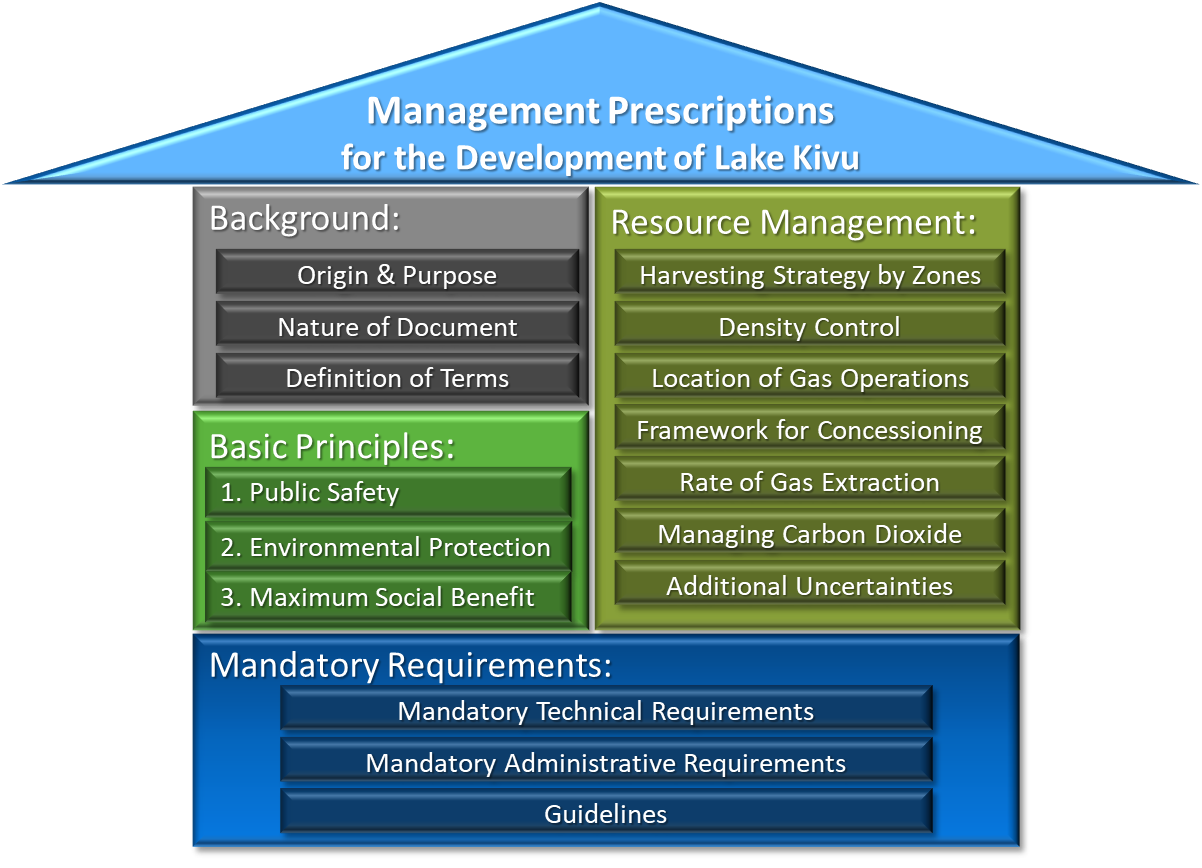
The key reference documents for Lake Kivu’s development are simplified below. They cover scientific and engineering solutions for Lake Kivu’s de-risking. Each of these documents carries an extensive listing of additional reference documents, if required.
Reference Documents: Regulation
Reference Documents: Supporting Research
- Elsevier: Journal of African Earth Sciences, Volume 161, January 2020
Managing the dangers in Lake Kivu – How and why?

Abstract:
Lake Kivu is arguably the world’s largest natural freshwater bio-digester. The lake contains vast amounts of algae, providing feedstock for producing recoverable biogas. The lake may also be one of the world’s largest carbon sinks. Only the oceans contain more, at low concentrations. Kivu is a standout site due to its unique capability to store vast volumes of these greenhouse gases for millennia. We need to know more about the scientific and engineering solutions for Lake Kivu’s de-risking, so that it doesn’t become a killer lake.
Gas resources in-place can provide inexpensive power for the region’s population for generations. But a program to draw-down gas inventories is also essential to avert a massive limnic eruption.
Distinct layers within the lake form five unique, stratified gas containments. In fact, the lake’s salinity-based density gradients (chemoclines) clearly separate and define these strata. Therefore, left undisturbed, these containments retain the continuously generated, biogenic CH4 and CO₂. The gases are trapped in solution, as strata of varying concentrations.
The richest biogenic gas inventory is stored in the lower two strata of the lake. Significant volumes of CO₂ of magmatic origin also accumulate within this total gas inventory.
Gases are therefore accumulating ever closer to saturation levels. As such, they threaten to cause a future limnic eruption. For example, an eruption occurred at Lake Nyos in Cameroon in 1986 with 1746 reported casualties. In this case, an eruption is inevitable if not actively prevented. However Lake Kivu has the size, potential, location and gas inventory for even more dire consequences. An eruption may be of the order of 1000 times larger.
Outlining our Hypothesis in the Elsevier paper
We propose in this paper a novel hypothesis to interpret an improved understanding of the lake’s history. As a key reference document, it uses a complex, multidisciplinary approach to analyse the lake’s unique situation. Our hypothesis identifies the impact of diffusion mechanisms on vertical transport of gas and nutrients in the lake. Through this body of work, one can foresee the probable outcomes and recognize the effects of system constraints.
One should initiate gas extraction projects on a basis that enables three vital outcomes. These are; a) for developers to pursue economic projects, while b) society enforces developers to follow extraction methods that ensure safety, through lifetime prevention of disasters, while c) gas extraction maximizes useful energy output.
The key to safety is proper management of the chemoclines. This must be achieved while drawing down the gas inventory. The instrument to achieve both, safely and productively, is derived from defining and making the right processing choices. The choices correctly specify all critical requirements for plant design of gas production facilities. Indeed, these are derived from thorough analysis of what may happen and what must be done technically.
Fulfilling the Principles
We must first deal with the primary concern for continued public safety. Thereafter we can examine, through further analysis, ways of minimizing environmental impact on the mixolimnion. Slow, natural upwelling of meteoric water out of surrounding lava strata causes impactful changes to the stratification.
These meteoric waters flow into the mixolimnion of one of the world’s most nutrient-rich water bodies. In addition, we need to consider the impact of washing the extracted raw gas with some of this water. This scrubbing of unwanted gas is essential to upgrade gas quality for use in power-generating engines. The wash water source is from the shallow stratum of the mixolimnion.
Finally, we consider how to continue holding the chemoclines at their current levels. To achieve this need, we discuss how to evacuate a fraction of the degassed water from deeper resource strata. Counter-intuitively, the best solution may be to reinject degassed water into the mixolimnion, in the top 60m of the lake.
Displacing degassed water can maintain chemoclines in place. However, it introduces an environmental challenge. The challenge lies in defining how to minimize any safety-driven or environmental impacts on the mixolimnion. Potential toxic effects come from H₂S, from CO₂-induced acidity, and from oxygen depletion caused by CH4 and H₂S.
One Sentence Summary:
Defining the role and methods of sustainable commercial gas extraction as a reference document for the scientific and engineering solutions for Lake Kivu, that for the foreseeable future serve to avert a disastrous limnic eruption caused by nature’s continued accumulation of gases in Lake Kivu.
